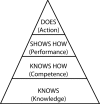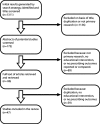Educational interventions to improve prescribing competency: a systematic review
- PMID: 23996821
- PMCID: PMC3758972
- DOI: 10.1136/bmjopen-2013-003291
Educational interventions to improve prescribing competency: a systematic review
Abstract
Objective: To review the literature on educational interventions to improve prescribing and identify educational methods that improve prescribing competency in both medical and non-medical prescribers.
Design: A systematic review was conducted. The databases Medline, International Pharmaceutical Abstracts (IPA), EMBASE and CINAHL were searched for articles in English published between January 1990 and July 2013.
Setting: Primary and secondary care.
Participants: Medical and non-medical prescribers.
Intervention: Education-based interventions to aid improvement in prescribing competency.
Primary outcome: Improvements in prescribing competency (knows how) or performance (shows how) as defined by Miller's competency model. This was primarily demonstrated through prescribing examinations, changes in prescribing habits or adherence to guidelines.
Results: A total of 47 studies met the inclusion criteria and were included in the systematic review. Studies were categorised by their method of assessment, with 20 studies assessing prescribing competence and 27 assessing prescribing performance. A wide variety of educational interventions were employed, with different outcome measures and methods of assessments. In particular, six studies demonstrated that specific prescribing training using the WHO Guide to Good Prescribing increased prescribing competency in a wide variety of settings. Continuing medical education in the form of academic detailing and personalised prescriber feedback also yielded positive results. Only four studies evaluated educational interventions targeted at non-medical prescribers, highlighting that further research is needed in this area.
Conclusions: A broad range of educational interventions have been conducted to improve prescribing competency. The WHO Guide to Good Prescribing has the largest body of evidence to support its use and is a promising model for the design of targeted prescribing courses. There is a need for further development and evaluation of educational methods for non-medical prescribers.
Keywords: EDUCATION & TRAINING (see Medical Education & Training); MEDICAL EDUCATION & TRAINING; THERAPEUTICS.
Figures
Similar articles
-
Beyond the black stump: rapid reviews of health research issues affecting regional, rural and remote Australia.Med J Aust. 2020 Dec;213 Suppl 11:S3-S32.e1. doi: 10.5694/mja2.50881. Med J Aust. 2020. PMID: 33314144
-
Improving the success of mailed letter intervention programs to influence prescribing behaviors: a review.J Manag Care Pharm. 2012 Oct;18(8):627-49. doi: 10.18553/jmcp.2012.18.8.627. J Manag Care Pharm. 2012. PMID: 23127150 Free PMC article. Review.
-
Prescriber Education Interventions to Optimize Opioid Prescribing in Acute Care: A Systematic Review.Pain Physician. 2019 Nov;22(6):E551-E562. Pain Physician. 2019. PMID: 31775401
-
The effectiveness of internet-based e-learning on clinician behavior and patient outcomes: a systematic review protocol.JBI Database System Rev Implement Rep. 2015 Jan;13(1):52-64. doi: 10.11124/jbisrir-2015-1919. JBI Database System Rev Implement Rep. 2015. PMID: 26447007
-
Toward Competency-Based Training: To What Extent Are We Competency-Based?Plast Reconstr Surg. 2021 Jul 1;148(1):122e-132e. doi: 10.1097/PRS.0000000000008059. Plast Reconstr Surg. 2021. PMID: 34181620
Cited by
-
Teaching safe prescribing to medical students: perspectives in the UK.Adv Med Educ Pract. 2015 Apr 17;6:279-95. doi: 10.2147/AMEP.S56179. eCollection 2015. Adv Med Educ Pract. 2015. PMID: 25945072 Free PMC article. Review.
-
CHIME-GP trial of online education for prescribing, pathology and imaging ordering in general practice - how did it bring about behaviour change?BMC Health Serv Res. 2023 Dec 2;23(1):1346. doi: 10.1186/s12913-023-10374-1. BMC Health Serv Res. 2023. PMID: 38042789 Free PMC article.
-
Can a novel constructivist theory-informed feedback intervention reduce prescribing errors ? A pre-post study.BMC Med Educ. 2023 Mar 7;23(1):150. doi: 10.1186/s12909-023-04095-6. BMC Med Educ. 2023. PMID: 36882779 Free PMC article.
-
The Impact of COVID-19 on Knowledge, Beliefs, and Practices of Ni-Vanuatu Health Workers Regarding Antibiotic Prescribing and Antibiotic Resistance, 2018 and 2022: A Mixed Methods Study.Trop Med Infect Dis. 2023 Oct 18;8(10):477. doi: 10.3390/tropicalmed8100477. Trop Med Infect Dis. 2023. PMID: 37888605 Free PMC article.
-
A Rapid Review of Prescribing Education Interventions.Med Sci Educ. 2020 Nov 16;31(1):273-289. doi: 10.1007/s40670-020-01131-8. eCollection 2021 Feb. Med Sci Educ. 2020. PMID: 34457882 Free PMC article. Review.
References
-
- Hanes C, Bajorek B. Pharmacist prescribing: is Australia behind the times? Aust J Pharm 2004;85:680–1
-
- De Vries TP, Henning RH, Hogerzeil HV, et al. Guide to good prescribing. Geneva: World Health Organisation, 1994
-
- Bryony Dean F, Vincent C, Schachter M, et al. The incidence of prescribing errors in hospital inpatients: an overview of the research methods. Drug Saf 2005;28:891–900 - PubMed
-
- Coombes ID, Stowasser DA, Coombes JA, et al. Why do interns make prescribing errors? A qualitative study. Med J Aust 2008;188:89–94 - PubMed
LinkOut - more resources
Full Text Sources
Other Literature Sources
Miscellaneous


